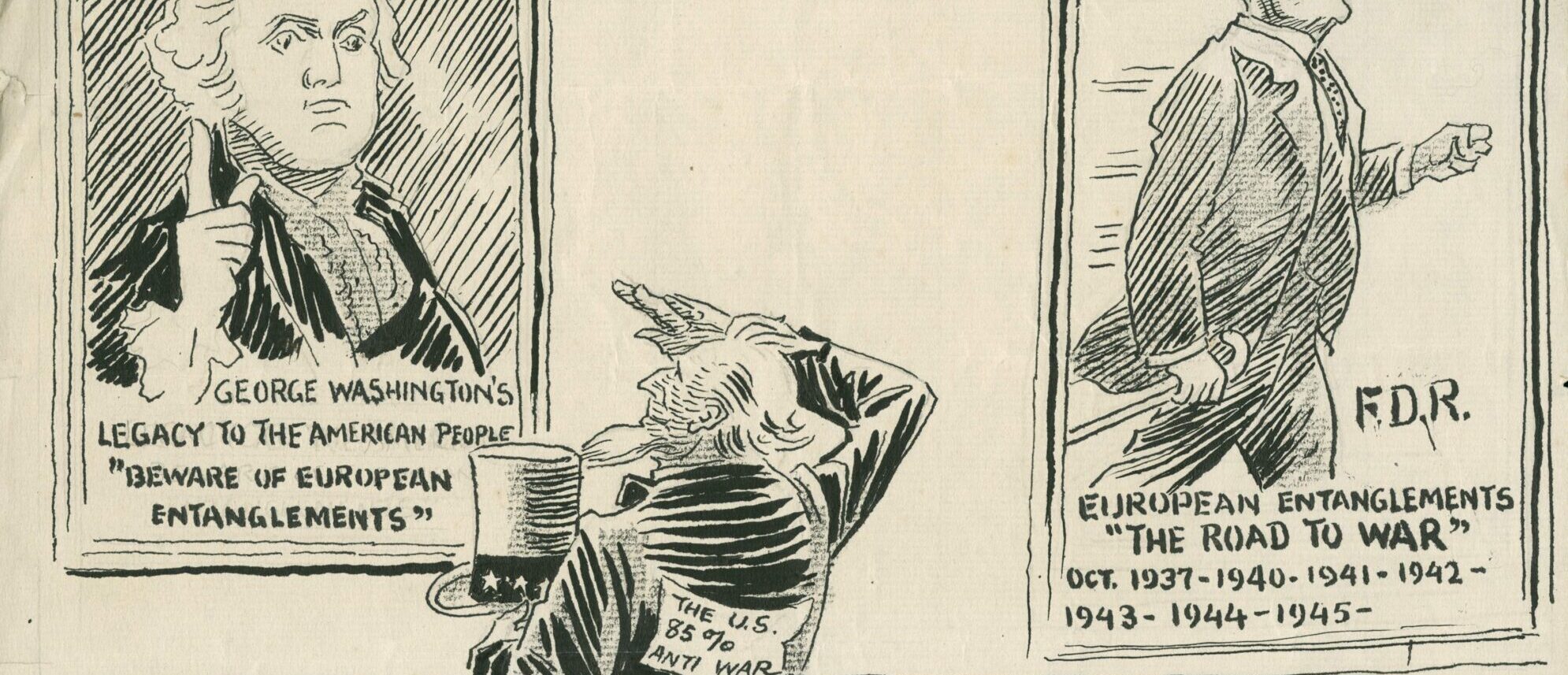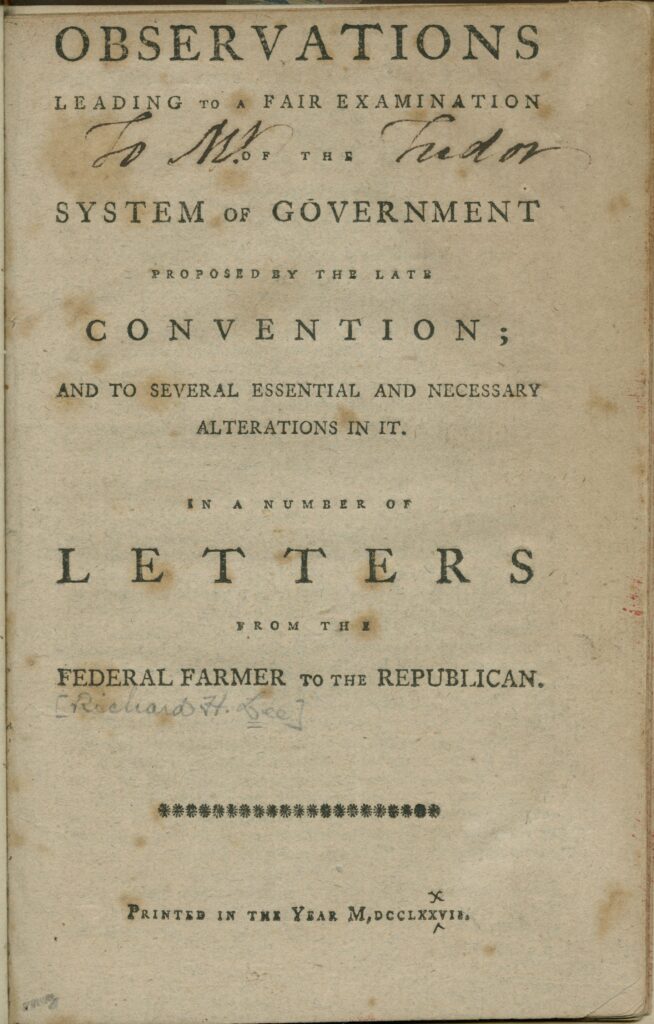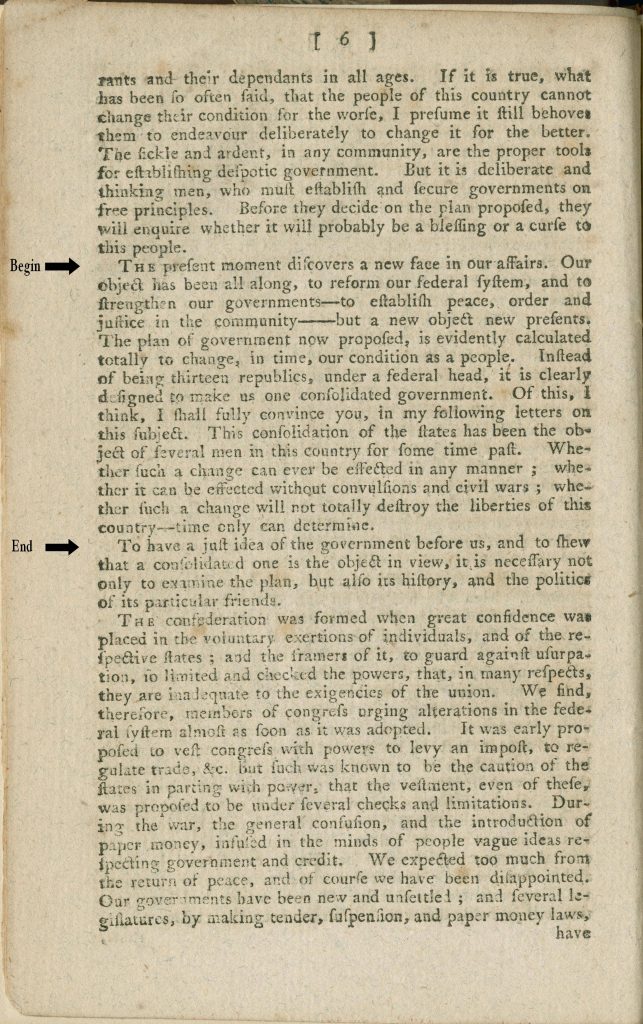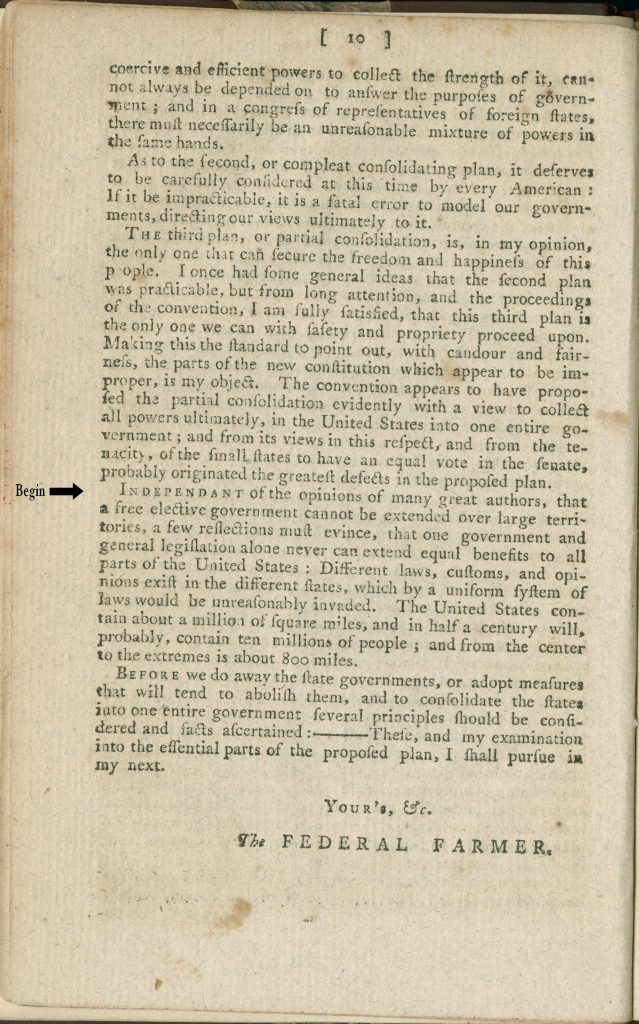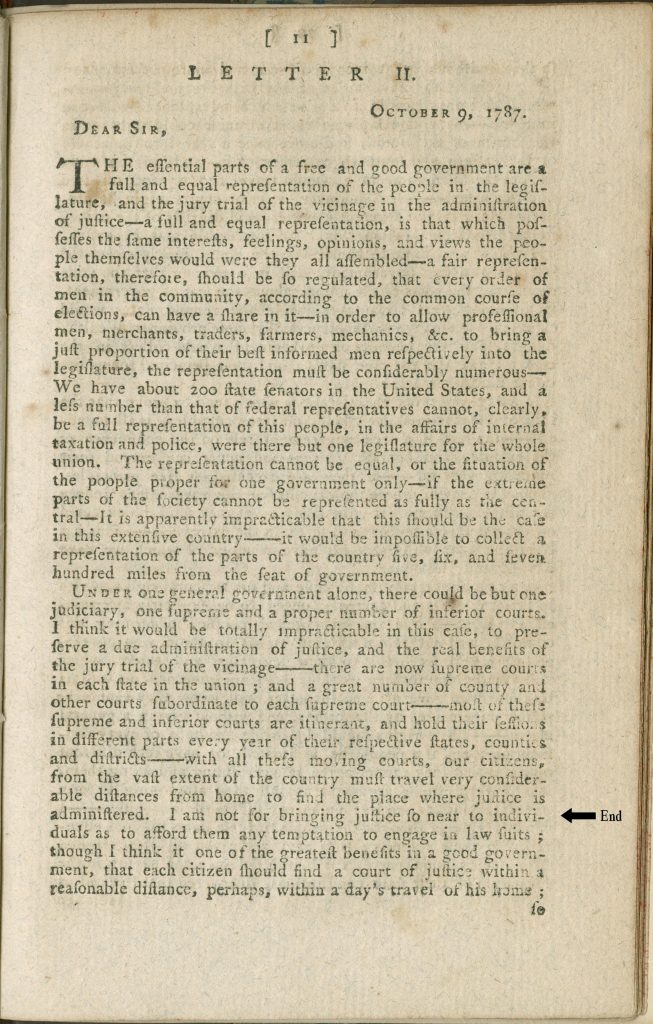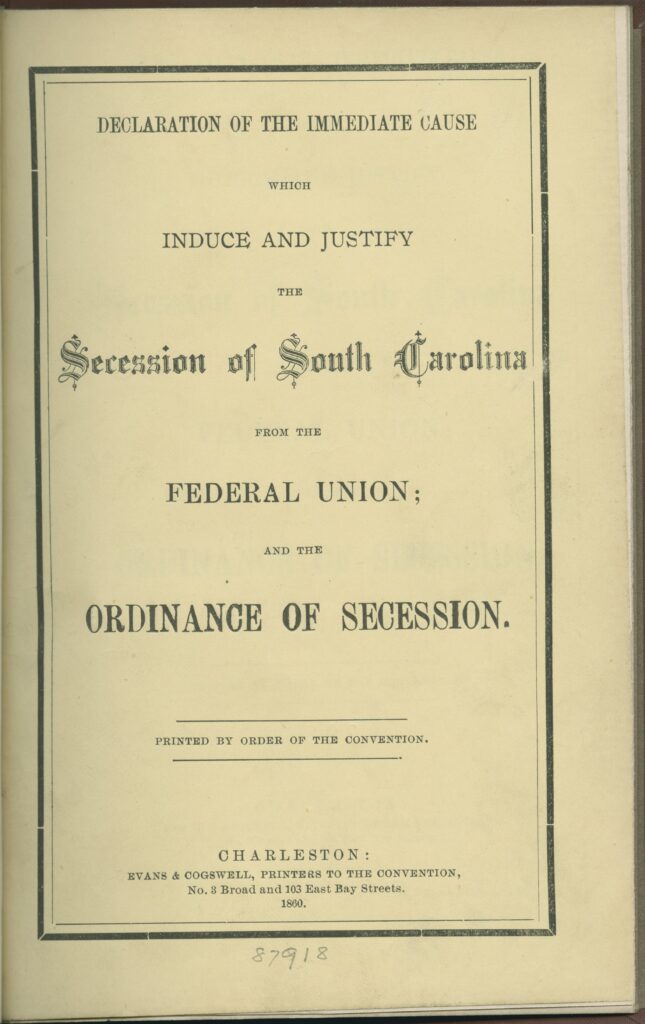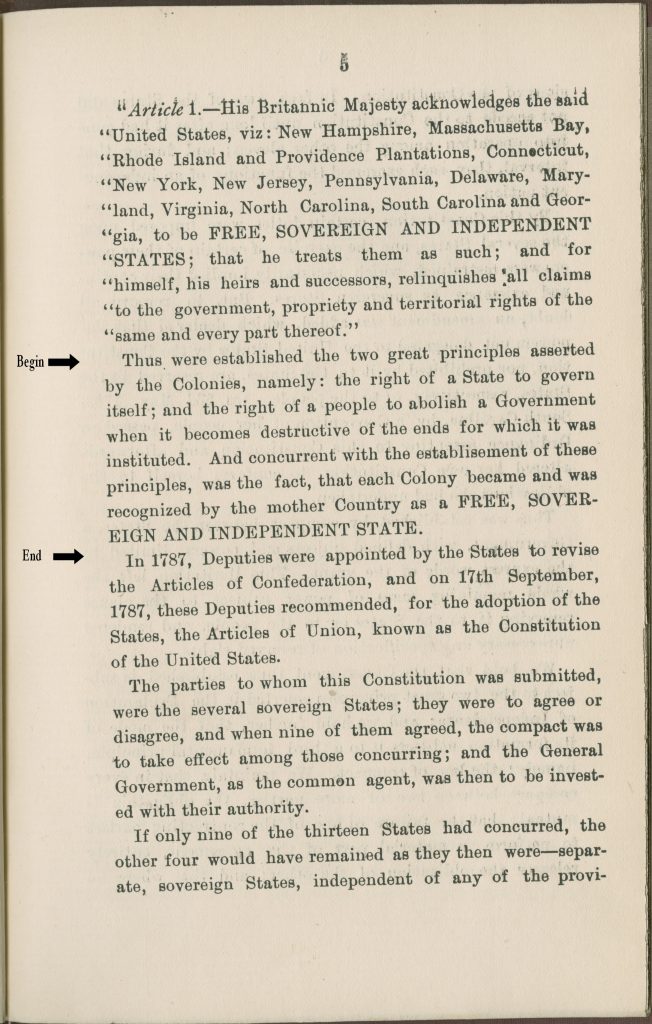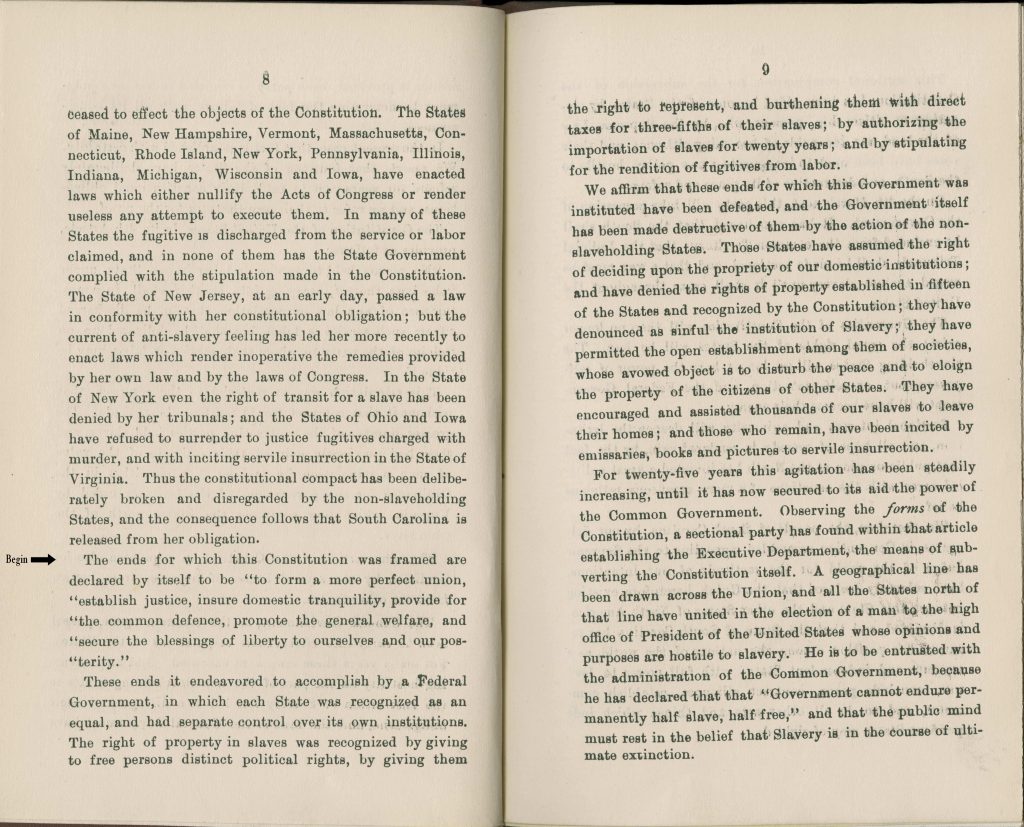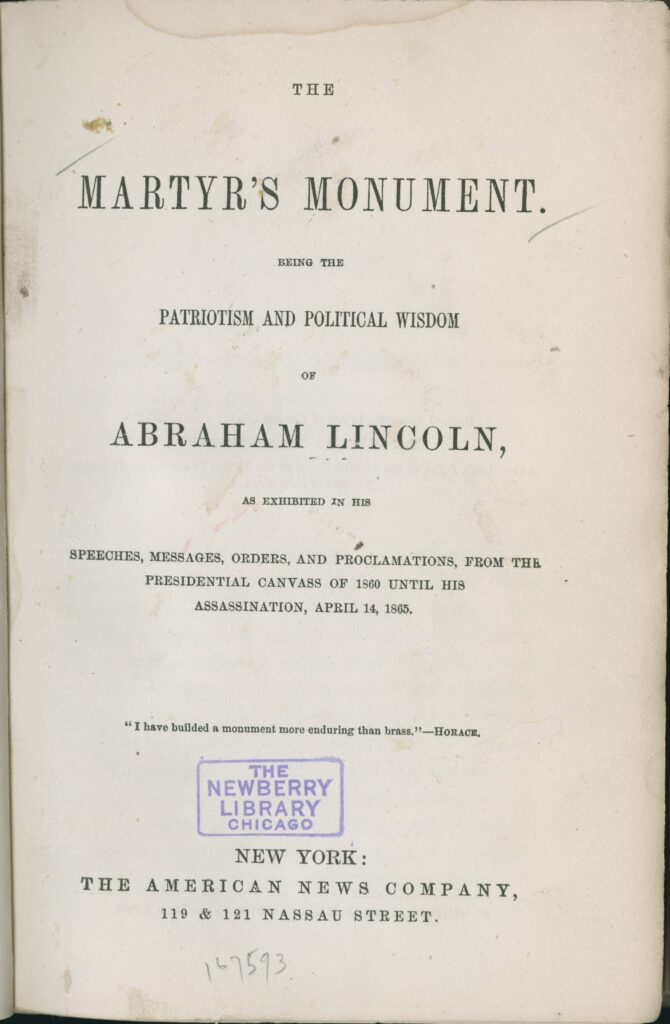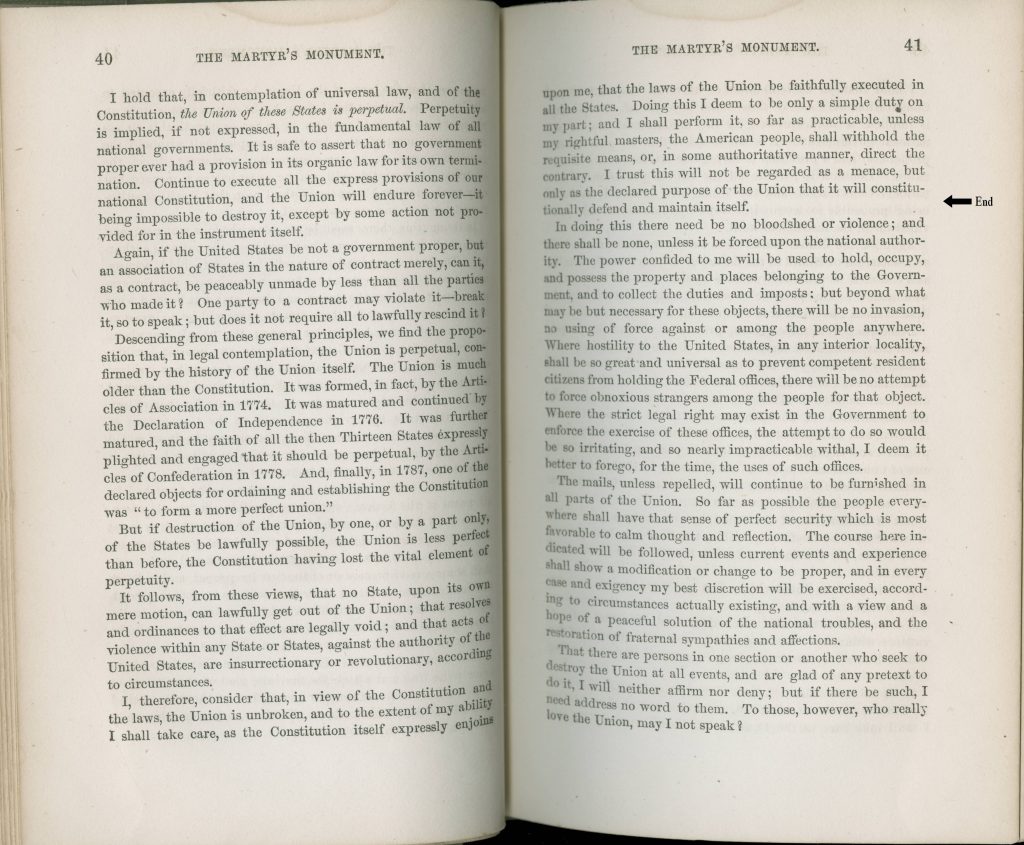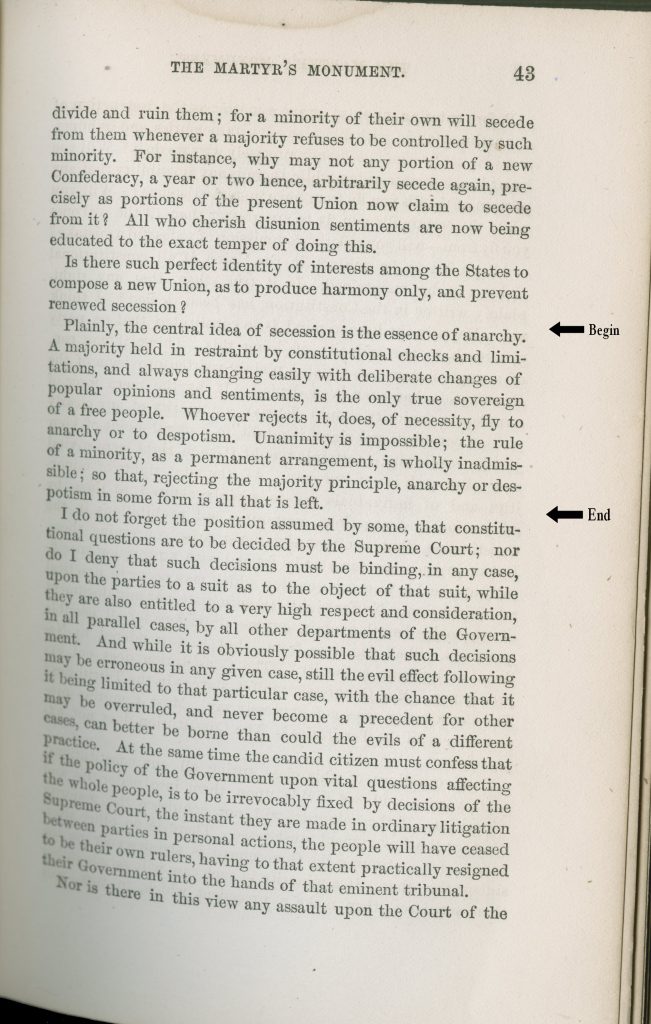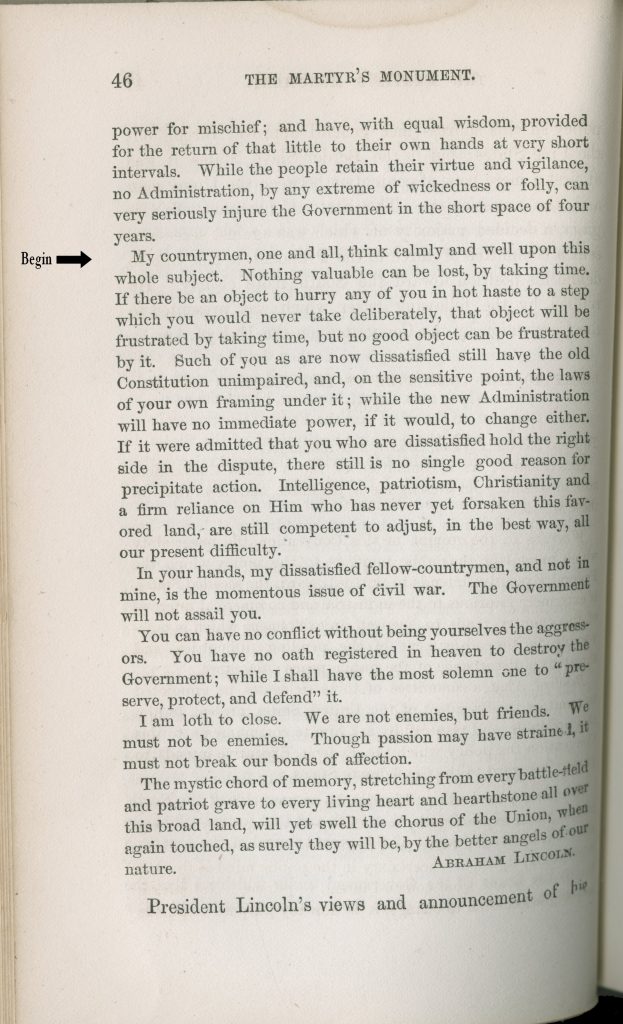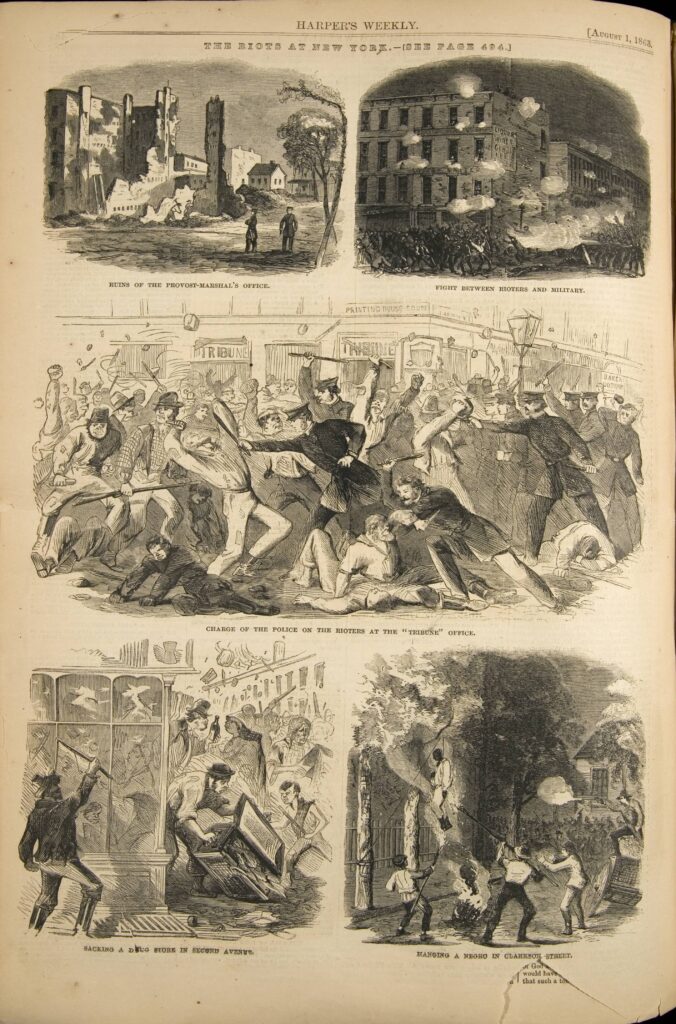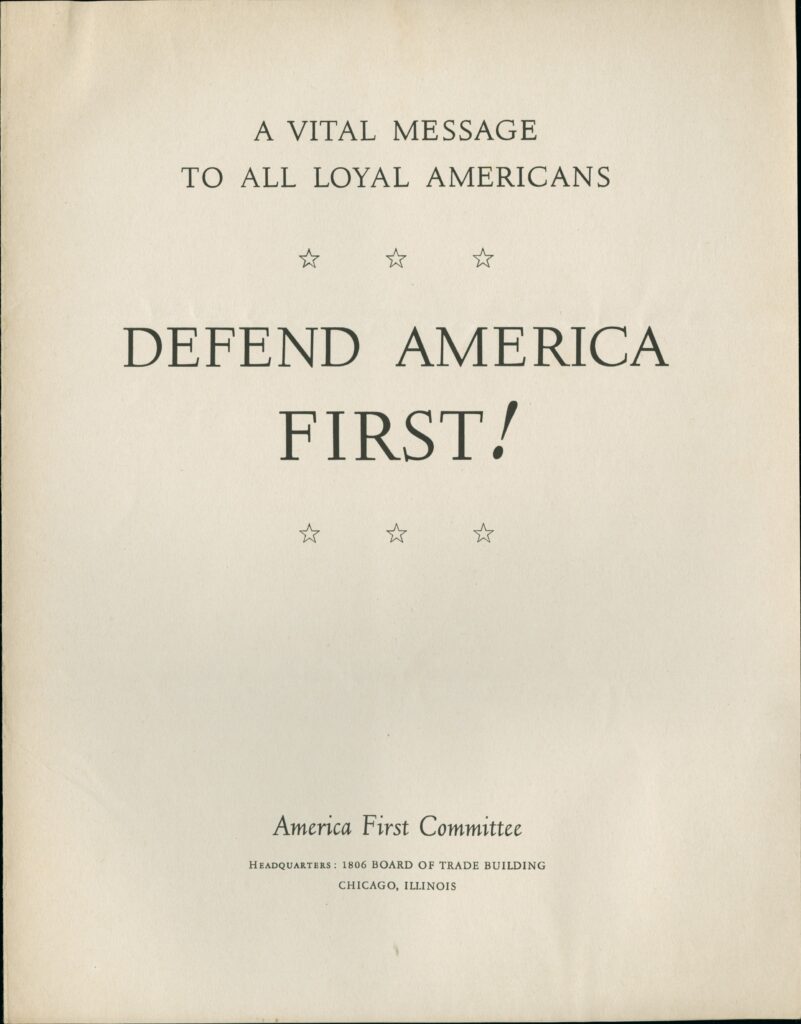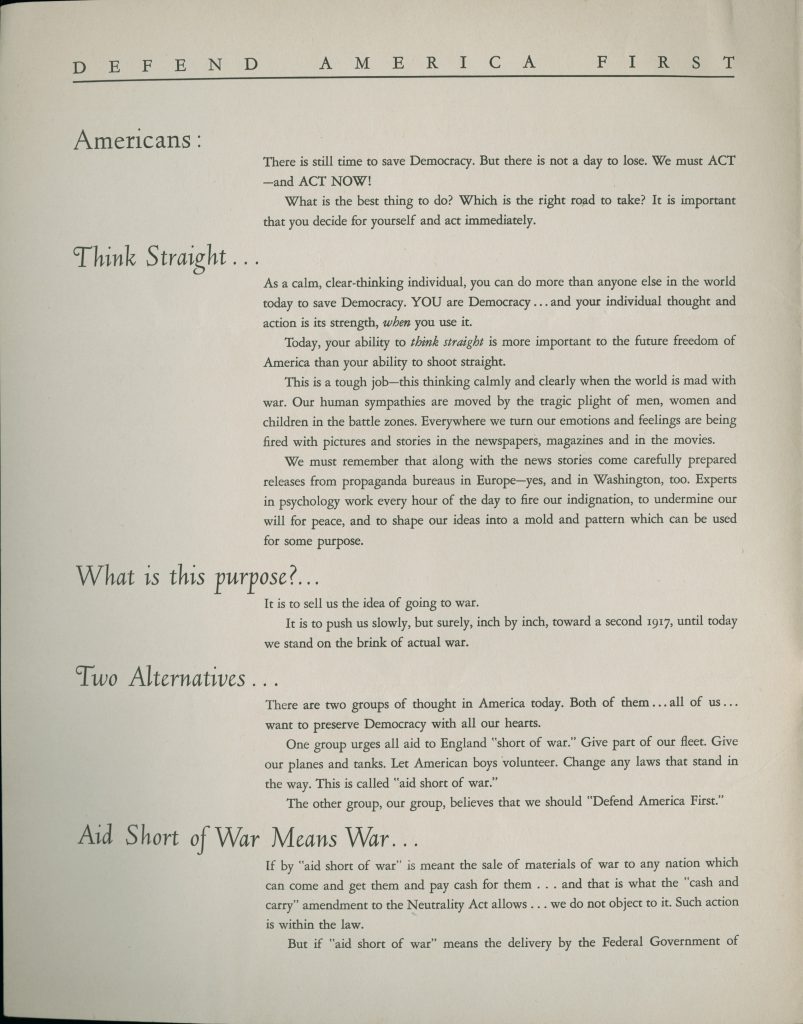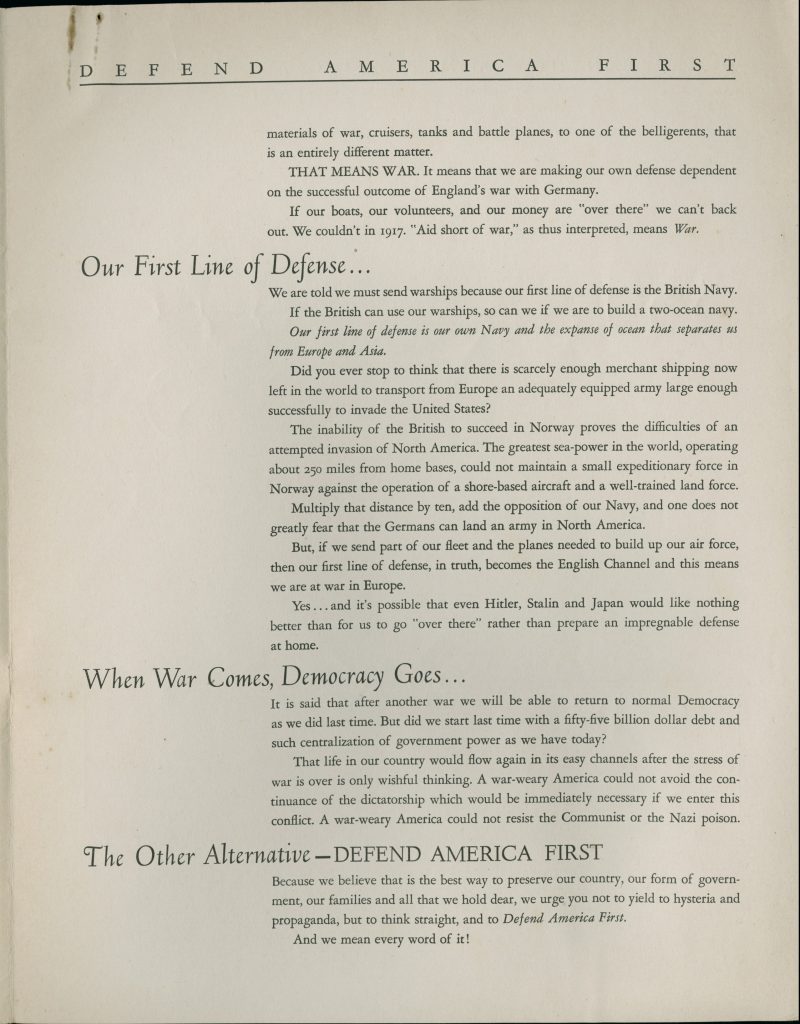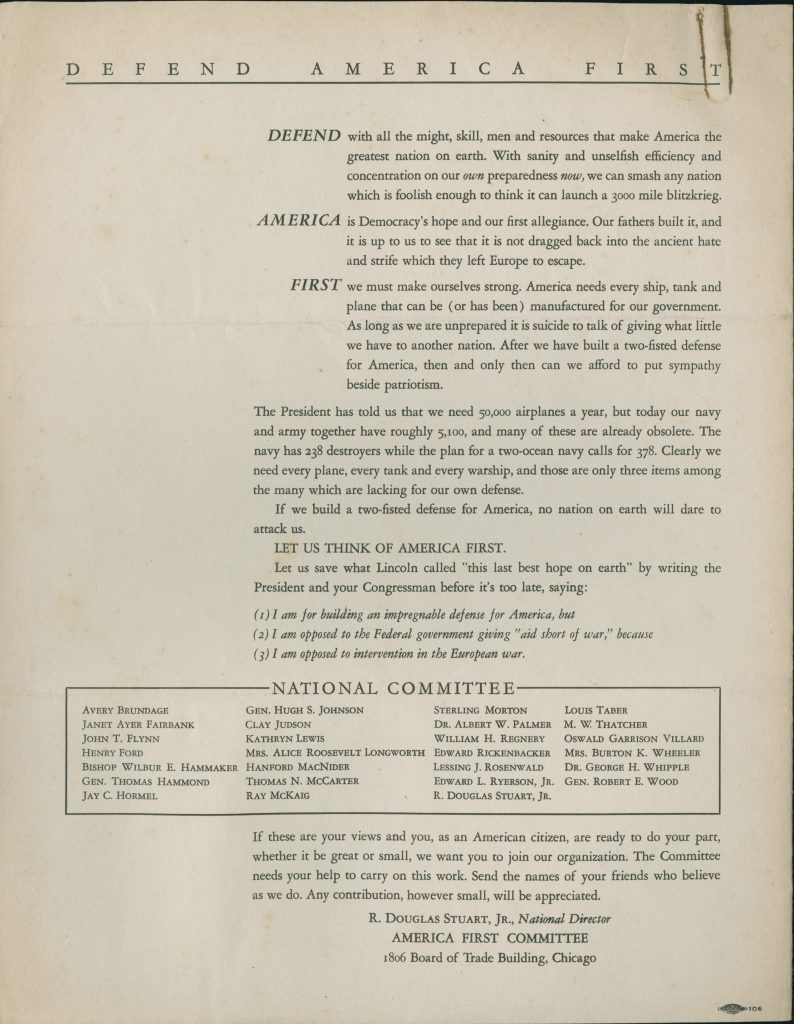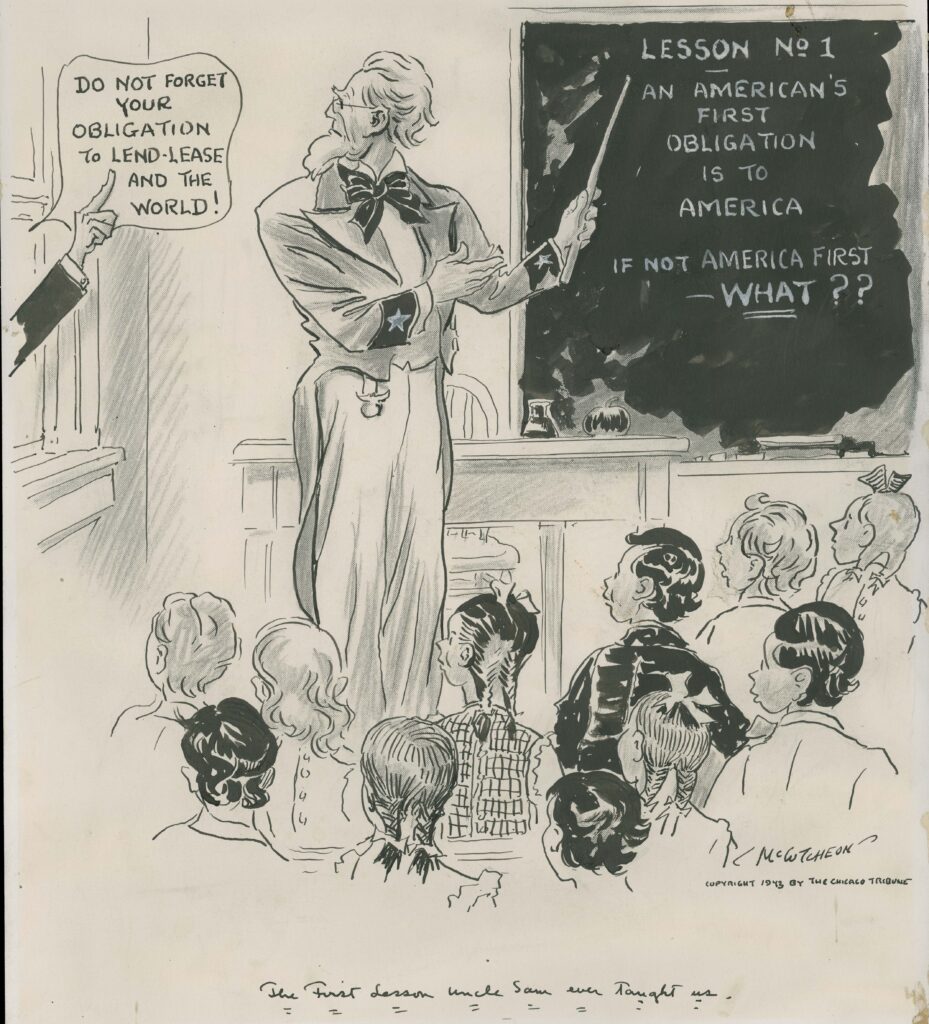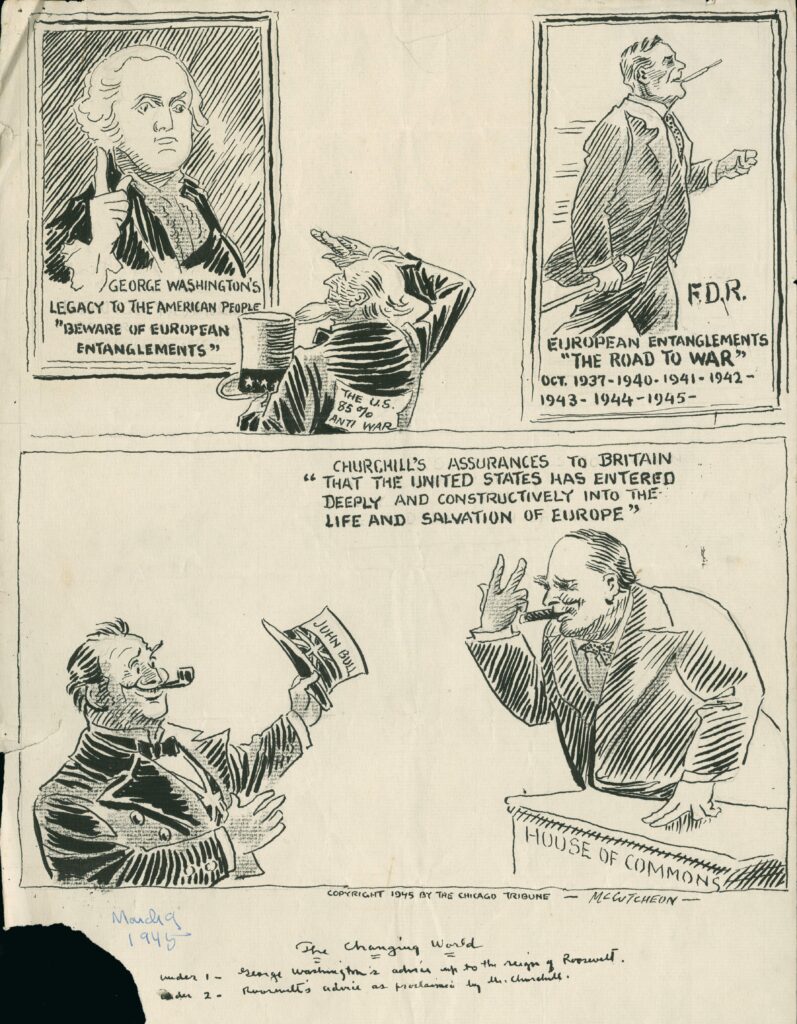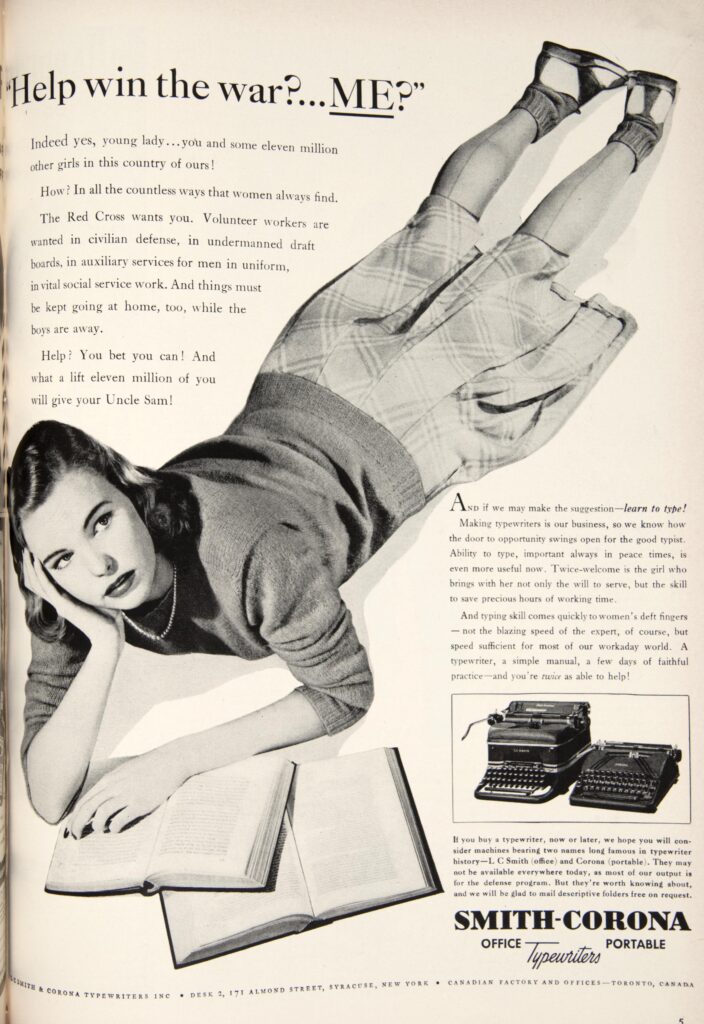Introduction
The United States came into being through a colonial revolt against the British monarchy and, ever since, Americans have remained uneasy about the power of the State, or centralized, national government. From the eighteenth century on, American intellectual and political life has included a strong current of anti-statism, hostility toward centralized authority. The nation’s founding documents lay out a vision of limited, federal power: The Declaration of Independence asserts that government exists in order to ensure the rights that people naturally and inherently possess. A just government depends on “the consent of the governed” and “whenever any Form of Government becomes destructive of these ends, it is the Right of the People to alter or to abolish it, and to institute new Government.” These two claims have been extraordinarily important in shaping American political thought: individual liberty takes precedence over government authority and people have the right to overthrow a government that violates their rights to “life, liberty, and the pursuit of happiness.”
The Declaration of Independence asserts that individual liberty takes precedence over government authority and people have the right to overthrow a government that violates their rights.
However, anti-statism is, of course, not the only influence within American thought. The Founders could not just reject a government; they also had to create a new one. Initially, under the Articles of Confederation, they designed a very weak national authority and granted each of the 13 states considerable power to independently manage its own affairs. But just five years after the end of the Revolution, a group of citizens called Federalists concluded that this weak national government was a failure. They argued that the country required a stronger federal authority with the power to raise taxes, to regulate interstate commerce, and to conduct relations with foreign countries, among other things. The Federalists supported the ratification of the Constitution, which would establish a stronger central government. Throughout U.S. history, anti-statist currents have regularly come into conflict with demands such as these for the State to play a more active role in managing the nation and its citizens.
The following collection of documents explores conflicts over the exercise of State power at three important junctures in U.S. history: the Revolution and national founding, the Civil War, and World War II. At each of these formative moments in national history, some Americans challenged—while others defended—the authority of the federal government over individual citizens and states. It is important to note that, in these documents, anti-statism does not emerge as a coherent ideology. Rather it includes many different forms of opposition to centralized authority, from reasoned debate to organized rebellion to mob violence. What does emerge is a long and varied history of American anti-statist thought and sentiment.
Please consider the following questions as you review the documents:
- What reasons do these writers, politicians, and demonstrators provide for protesting the authority of the State? Why do they perceive the State as a threat? What does it threaten?
- How do these writers, politicians, and demonstrators choose to express their objections? Why do some choose to publish and engage in debate, while others encourage violent action? What are the results of each approach?
- What distinguishes anti-statist thought from other ways of criticizing a president’s policies? What differences exist between any criticism of a given administration and criticism that specifically invokes anti-statist sentiment?
- How has this intellectual and political current changed over time? What remains the same? What, if anything, unifies the American tradition of anti-statism?
Resistance to British Government
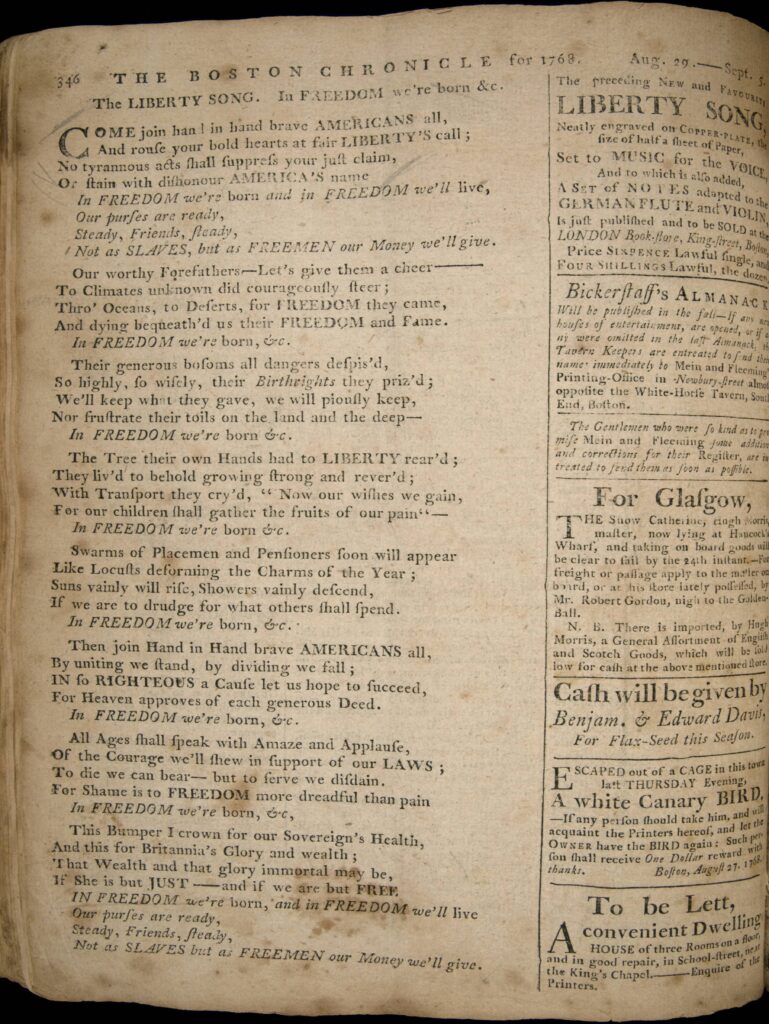
John Dickinson’s “Liberty Song” is considered America’s first significant political song. It was inspired by the Massachusetts Legislature’s “Circular Letter,” published in February 1768. This letter was written by Samuel Adams to protest the Townshend Acts, laws passed by the British Parliament which taxed colonists for goods such as paper, paint, glass, and tea. The taxes were part of a series of laws, including the Stamp Act and the Sugar Act, designed both to raise revenue and to assert tighter political control over the colonies. When Boston residents resisted paying the taxes, the British government sent troops to occupy the city. The conflict resulted in the Boston Massacre of 1770 and set the stage for the Revolution six years later.
Questions to Consider
- What does “The Liberty Song” mean by the terms freedom and liberty?
- How does it position freedom as fundamental to the colonists’ character?
- What kind of relationship exists or should exist between the people and the State, according to this song?
- Why do you think these taxes imposed by the British Parliament provoked such deep opposition among colonists?
The Debates over the Constitution
During the years 1787 and 1788, Americans hotly debated the merits of the proposed Constitution in newspapers and state legislatures. The essays published under the pseudonym Federal Farmer present some of the more moderate and most influential arguments against the proposed Constitution. Scholars believe the essays were probably written not by a farmer, but by a New York merchant, Melancton Smith, who spoke against the Constitution at New York’s ratification convention. Some Anti-Federalists advocated direct democracy, or the popular participation in government that is only possible when government is local and the population is small, as in rural areas. Others, including Federal Farmer, did not promote populism or agrarianism, but believed in the importance of state legislatures to act as the people’s representatives. Both Anti-Federalist groups expressed concern that the proposed Constitution did not specifically identify the rights held by individuals that the government must respect. They feared that the consolidation of power in the national government would undermine individual liberties and empower a small political elite.
Selection: Federal Farmer, Observations Leading to a Fair Examination of the System of Government Proposed by the Late Convention (1787)
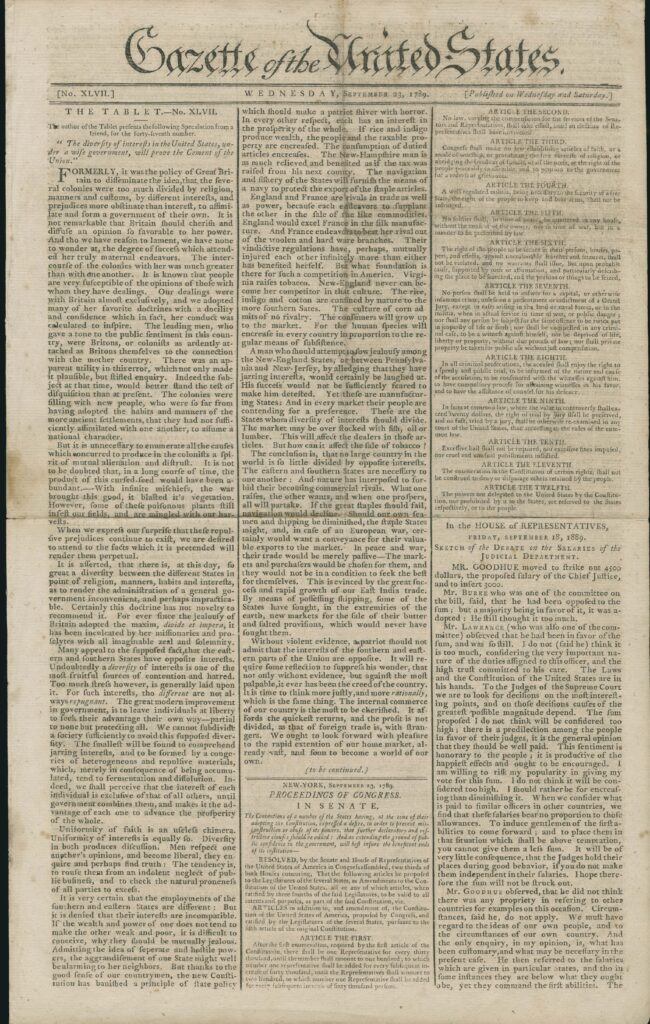
In the excerpt above, Federal Farmer warns of the dangers of a large republic. James Madison famously challenged these arguments in Federalist 10, arguing that only a large republic could limit the power of factions. The September 1789 article included here from New York’s Gazette of the United-States suggests how, even after the Constitution’s ratification, Americans continued to debate its merits and, specifically, to address the issue of the republic’s size and regional differences. The article opens with the quote: “The diversity of interests in the United States, under a wise government, will prove the Cement of the Union.” The Gazette also presents the first twelve proposed amendments to the Constitution. Ten of these amendments would be ratified by state legislatures over the coming years and would become known as the Bill of Rights. These amendments won over a number of Antifederalists who had previously opposed the Constitution.
Questions to Consider
- What objections does the Federal Farmer make to the proposed Constitution? Why does the size of the republic’s territory and population threaten to undermine its representative form of government?
- What are the virtues of a large, diverse republic, according to the Gazette writer?
- Which rights are enumerated in the proposed amendments published here? Which two would not, ultimately, be ratified? Why do you think those two were not approved by enough state legislatures? How do the ten amendments known as the Bill of Rights serve to limit the power of the federal government?
- Consider how these debates over the proposed Constitution were waged through newspaper and pamphlet publications. What is the role of the press in limiting the power of the federal government?
Southern Secession
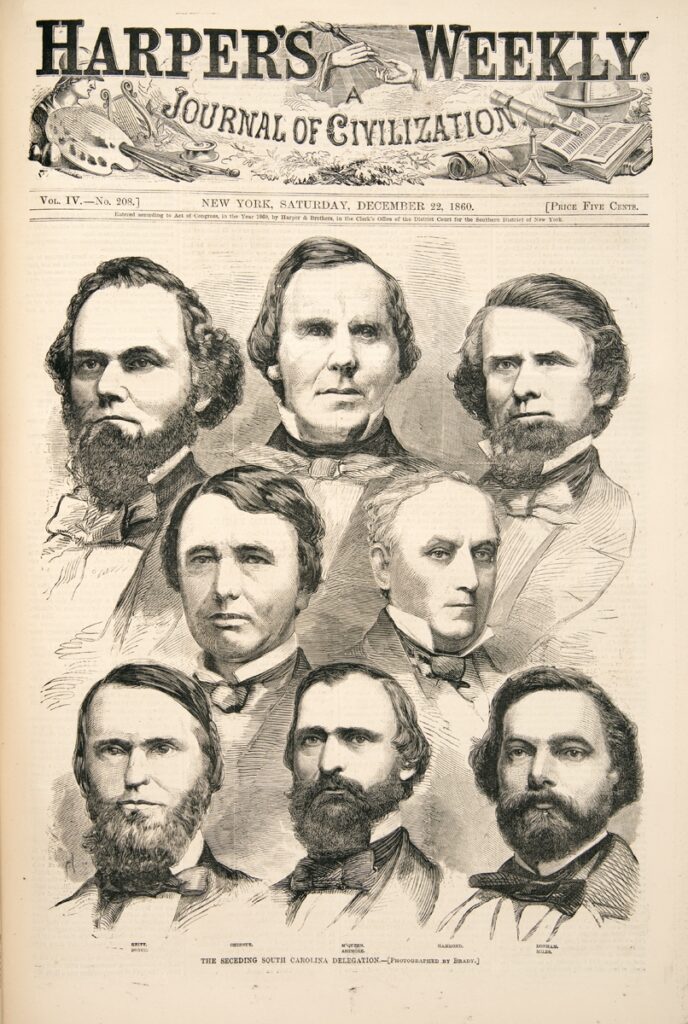
The most profound challenge to the authority of the federal government occurred when Southern states attempted to leave the Union and form an independent country, the Confederate States of America, in the 1860s. Regional tensions had been rising for decades over the question of whether slavery would extend into the new territories west of the Mississippi. Abraham Lincoln’s election as president in the fall of 1860 prompted Southern secessionists to act. Lincoln insisted that he did not intend to interfere with the institution of slavery in the southeastern states where it already existed. However, he was firmly opposed to allowing slavery in the new territories and openly declared his personal belief that slavery was wrong. South Carolina led the movement and declared its secession on December 20, 1860. Six other states joined South Carolina before Lincoln’s inauguration in March 1861. A total of 11 states would eventually attempt to secede.
Selection: Declaration of the Immediate Causes Which Induce and Justify the Secession of South Carolina from the Federal Union (1860)
The documents in this section include a portrait of the South Carolina Congressional delegation, an excerpt from a pamphlet explaining their decision to secede, and excerpts from Lincoln’s first inaugural address in which he provided his first full public defense of federal authority in the face of the Southern secession.
Selection: Abraham Lincoln, First Inaugural, in The Martyr’s Monument Being the Patriotism and Political Wisdom of Abraham Lincoln (1865)
Questions to Consider
- Examine the portraits of South Carolina’s delegation on Harper’s December 1860 cover. The accompanying article offers tribute to these “Gallant gentlemen, with high endowments, manly attributes, and … integrity” and provides a brief biography of each. How does the magazine portray the South Carolinians? What does the Harper’s coverage of secession suggest about New Yorkers’ responses to the Southern states’ actions?
- What reasons do South Carolina’s leaders give for secession? How do they link secession to the principles of the American Revolution and defend it as a Constitutional right? Are their arguments based on the rights of individual citizens, individual states, or both?
- What are South Carolina’s leaders’ arguments regarding slavery? How do they interpret the Constitution concerning the matter of slavery?
- What is Lincoln’s critique of the secessionists’ arguments? How does he interpret the Constitution regarding the question of the right to secede? Why does he associate secession with anarchy?
- Which arguments—Lincoln’s or the secessionists’—do you find more persuasive? Why? Which side more accurately interprets founding documents, such as the Declaration and the Constitution?
Anti-Statism in the North
Southern secessionists were not the only Americans to challenge the authority of the federal government during the Civil War. During the first two years of the war, each state had been responsible for recruiting soldiers for its regiments. In March 1863, after a series of losses on the battlefield, Lincoln concluded that the army needed more soldiers. He signed into effect the Union’s first military draft, which required every male citizen between the ages of 20 and 45 to enroll. Men were expected to serve if called, or pay a commutation fee, or hire a substitute. Many poor and working-class men could not afford such payments and resented seeing the wealthy avoid service. These working-class whites also expressed fear of job competition from slaves freed by the Emancipation Proclamation issued earlier that year. Protests erupted in cities and towns throughout the North. The most violent occurred in New York City, where mobs, consisting largely of Irish immigrants, rioted for five days. They attacked the provost marshal’s office, where the draft was taking place, then vented much of their rage on the city’s African American community. Over the course of the week, the rioters lynched 11 black men, burned an orphanage for black children, looted and destroyed numerous black-owned businesses, and forced hundreds of African Americans out of the city. The New York–based magazine, Harper’s Weekly, provided extensive coverage of the draft riots, including the illustrations below.
Selection: “The Riots at New York” in Harper’s Weekly (August 1, 1863)
Questions to Consider
- How does Harper’s portray the draft rioters and their actions in the summer of 1863? What do the images suggest about perceptions of Irish immigrants?
- Who do the rioters seem to have targeted? Why would they attack many people who have no connection to the draft or to the government?
- How do the mob’s actions challenge federal authority? How do their actions compare to the Southerners’ efforts to leave the Union? What are the differences and the similarities in how each group expressed opposition to the State?
Opposition to U.S. Involvement in World War II
Franklin Delano Roosevelt was elected president in 1932. The nation was two years into the Great Depression, an extraordinary economic collapse during which Americans experienced 25 percent unemployment and widespread poverty, hunger, and homelessness. Roosevelt responded by immediately proposing a series of laws, known as the New Deal, which would dramatically increase the size and scope of the federal government. New Deal legislation sought to strengthen federal regulation of business, to stimulate the economy, to provide greater protections for workers, and to increase government assistance to people during hard times. However, the Depression was still going on at the end of the 1930s as Hitler invaded Poland and Europe entered the Second World War.
Selection: America First Committee, Defend America First! (1940)
The United States public had been strongly isolationist, or opposed to U.S. involvement in international conflicts, since World War I. The pamphlet and editorial cartoons included here offer powerful expressions of that opposition. The America First Committee was among the most prominent anti-war organizations. It drew support from politicians and others on both the left and the right, though its most visible spokesman was the aviator Charles Lindbergh, a longtime critic of the Roosevelt administration. The group disbanded after the Japanese attack on Pearl Harbor in December 1941. The Chicago Tribune cartoonist John T. McCutcheon maintained his opposition throughout the war, as demonstrated by these illustrations.
Questions to Consider
- What are the America First Committee’s arguments for staying out of the war? In what ways does the pamphlet implicitly or explicitly criticize the Roosevelt administration?
- Does this pamphlet appeal to patriotism? How does the pamphlet differentiate between loyalty to America and suspicion or criticism of the federal government under Roosevelt?
- Examine the McCutcheon cartoons. What arguments do the cartoons present against U.S. involvement in the war? How does McCutcheon make use of founding principles to criticize Roosevelt’s policies? Why do you think the Tribune’s publisher, Robert R. McCormick, declined to publish the second cartoon, The Changing World?
- How do the America First and McCutcheon criticisms of Roosevelt administration policy tap into the wider tradition of anti-statism? What connections do they draw between an overly powerful national government and an activist foreign policy?
Supporting the War Effort
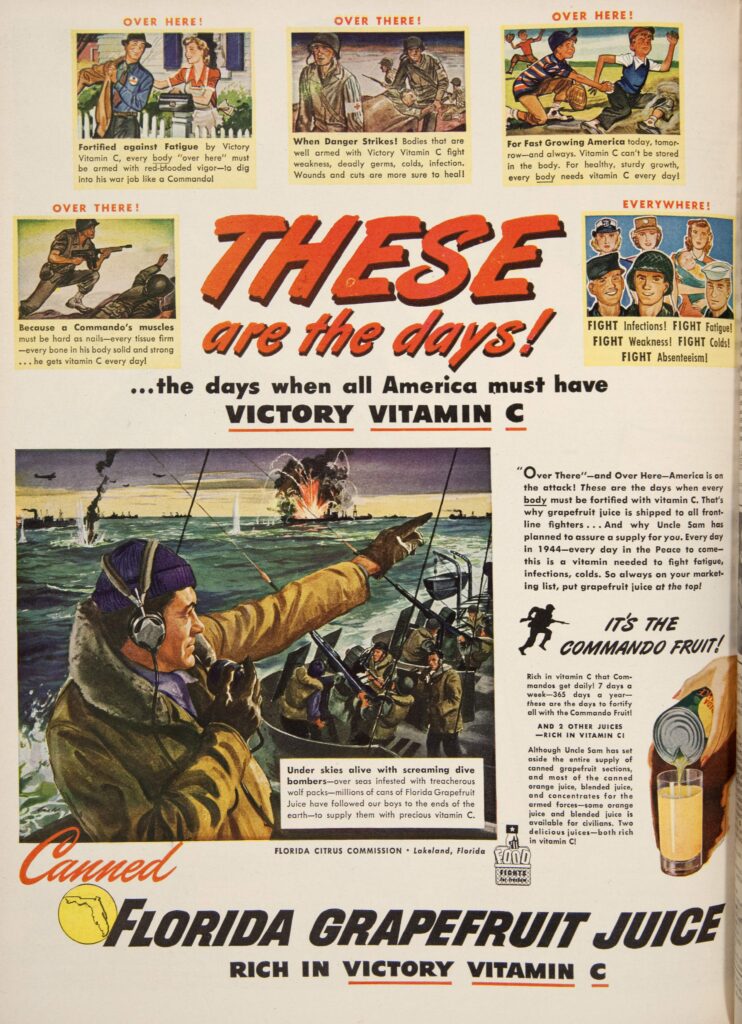
As Britain came under assault by Germany, Roosevelt tried to engage the United States in the war and to work around isolationist sentiment by devising the Lend-Lease Act. This law authorized the president to sell, lend, lease, exchange, or transfer war materials to any country whose defense he deemed essential to U.S. interests. In January 1941, Roosevelt presented his most compelling argument for U.S. involvement in World War II in his “Four Freedoms” speech in which he insisted that American democracy depended upon the survival of democracies in Europe. These advertisements, which appeared in Life magazine in 1942 and 1944, present unofficial arguments in support of the war effort. They indicate the extent to which private corporations and individuals embraced—or were expected to embrace—the war effort following Pearl Harbor.
Questions to Consider
- How do the Life advertisements urge all Americans to join the war effort? Why do the ads go to such lengths to appeal to people beyond those eligible to serve directly in the military?
- What differences and similarities do you notice between the U.S. Army recruitment ad and the ads of private organizations, such as the Florida Citrus Commission and Smith-Corona Typewriters?
- The Defend America First! pamphlet warns readers to beware of government- and media-generated emotional manipulation. Are these advertisements examples of the kind of propaganda against which the pamphlet cautions? Do the historical circumstances warrant this kind of media campaign?
- Did you see comparable media campaigns during the recent American wars in Iraq and Afghanistan? Why or why not? What do the differences or similarities suggest about the current American public’s relationship to these wars and to the national government?
Early Discussions about Central Authority
Civil War Period
Opposition to US Involvement in World War II
Promoting Involvement in World War II in Life Magazine
Further Reading
Saul Cornell. The Other Founders: Anti-Federalism and the Dissenting Tradition in America, 1788–1828. 1999.
Richard Colles Johnson and Cynthia H. Peters, compilers. A Princely Gift: The Rudy Lamont Ruggles Collection of the Newberry Library. 1986.
Jill Lepore. “Tea and Sympathy: Who Owns the American Revolution?” New Yorker May 3, 2010.
James T. Sparrow. Warfare State: World War II Americans and the Age of Big Government. 2011.



